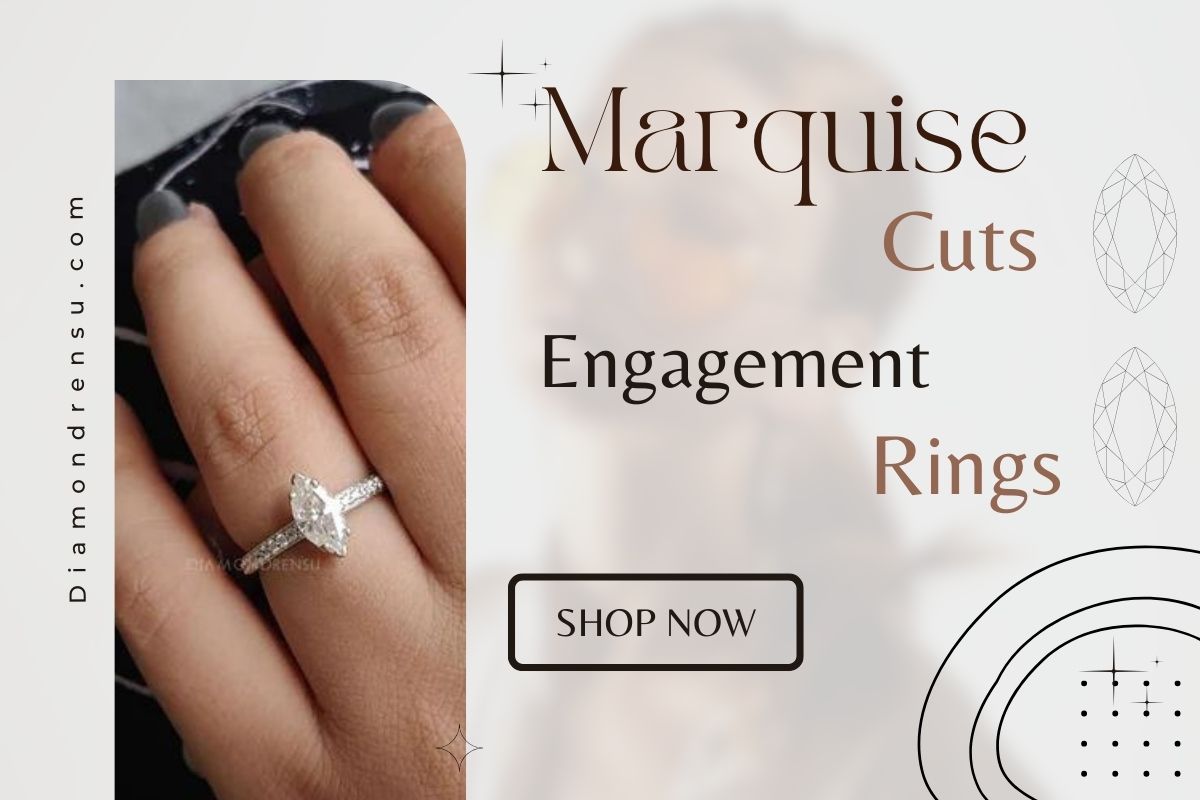
Marquise Cut Diamond Size Chart: Your Guide to Perfect Proportions
Understanding the various aspects of diamond cuts can greatly enhance one's ability to select the perfect gemstone.
My appreciation for the marquise cut diamond stems from its historical elegance and unique shape.
Characterized by its elongated body with pointed ends, this cut has origins that date back to the 18th century and carries a regal legacy influenced by French monarchy. It's crafted to maximize carat weight, give an illusion of greater size, and to flatter the finger with its distinct and sophisticated appearance.
When discussing marquise cut diamonds, sizing is an intricate subject that requires clarity and precision.
I recognize that simply knowing the carat weight of a diamond does not provide a comprehensive picture of its actual size and appearance.
Instead, one must consider both the carat and the specific dimensions of the gemstone to fully understand its presence in a setting.
The size chart for the marquise cut diamond, which translates carat weight to millimeters, is a vital tool for anyone looking to purchase this diamond shape. It allows for a visual representation that aids in anticipating the stone's proportions and how it will look once set into a piece of jewelry.
Selecting a marquise cut diamond involves balancing various factors such as length-to-width ratio, carat weight, and dimensions.
I focus on these details to assess the diamond's potential impact on aesthetics and value.
Knowledge of the proper proportions and size can influence the diamond's brilliance and its visual appeal, guiding potential buyers toward making informed and satisfying investments.
It is these specifics that enhance the overall experience of purchasing and owning a marquise cut diamond, ensuring it's as remarkable and cherished as intended.
Understanding Marquise Diamonds
Marquise diamonds are unique for their elongated shape, which creates an illusion of greater size. This cut is not only rich in history but also boasts an elegant appeal.
History and Origin
The Marquise cut has its roots in 18th century France, named after the Marquise of Pompadour, Jean Antoinette Poisson.
Commissioned by King Louis XV, the cut was created to resemble the Marquise's lips, which he considered perfect.
This historical origin adds a layer of romantic allure to the cut, which has evolved over time to become a symbol of sophistication and class.
The Marquise Shape and Appeal
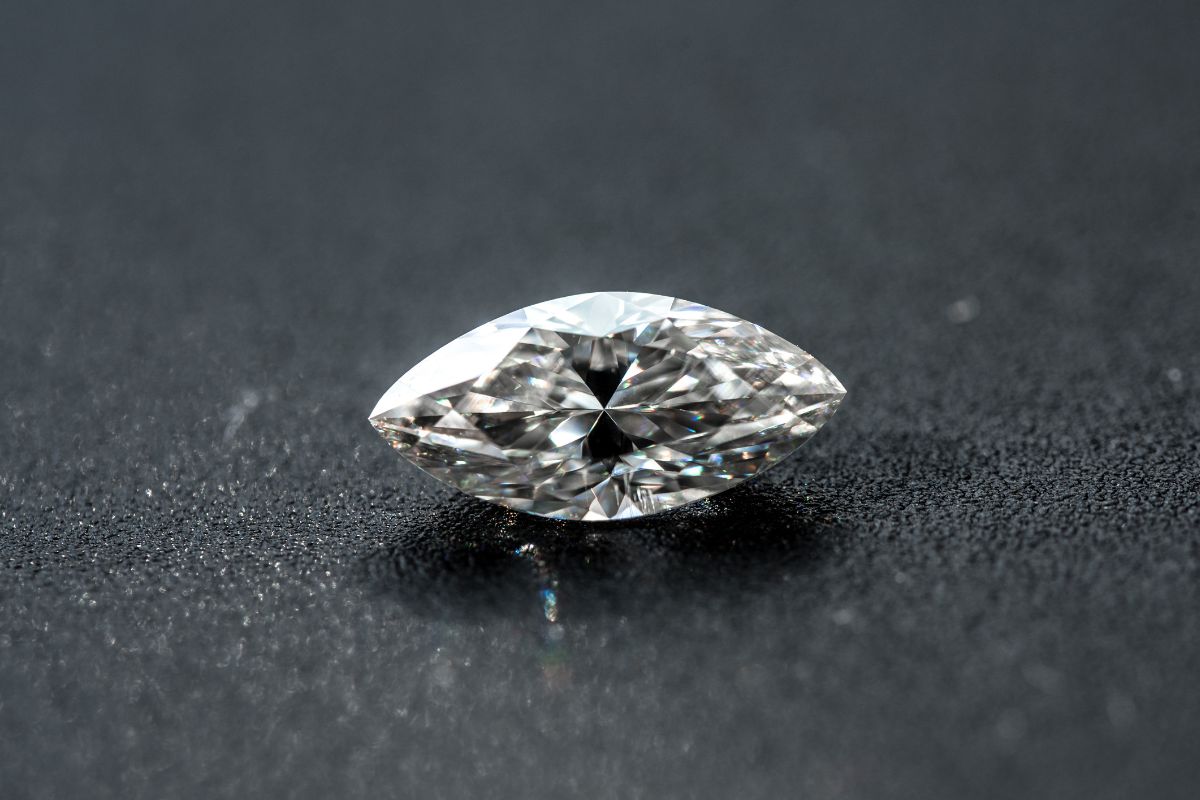
The marquise cut diamond is known for its unique shape, a blend of elongated form with pointed ends.
This distinctive silhouette is reminiscent of a football and is considered to make the finger of the wearer appear more slender and long.
Its appeal lies in its ability to stand out among other shapes due to its ability to appear larger than other diamonds of equal carat weight because of its larger surface area.
Characteristics of Marquise Cut
Characteristically, marquise cut diamonds have two opposing pointed ends with curved sides. This cut typically comprises 58 facets that reflect light to enhance its sparkle.
Its elongated shape helps optimize carat weight, making marquise diamonds appear larger than other shapes of a similar weight.
When choosing a marquise diamond, make sure to consider the length-to-width ratio, which should ideally be between 1.85 and 2.10 to ensure a balanced and symmetrical appearance.
Marquise Cut Diamond Size Chart
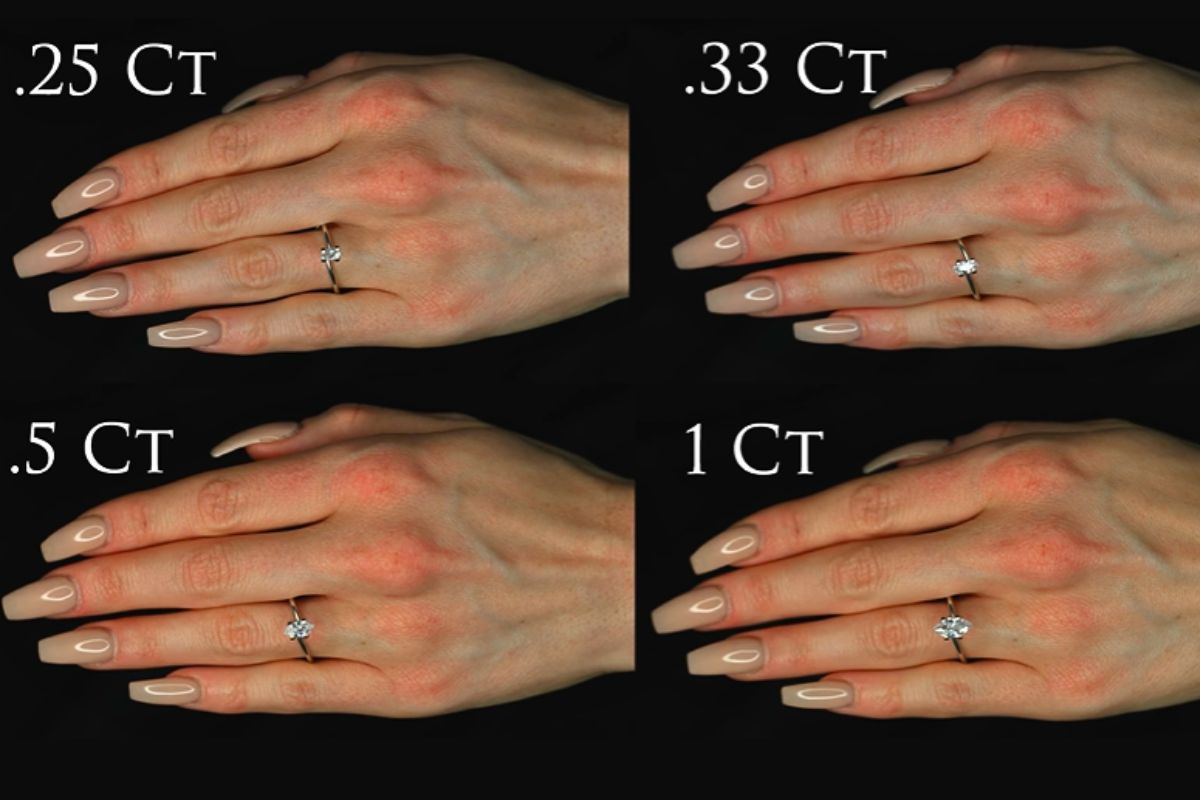
| Length (mm) | Width (mm) | Carat Weight |
|---|---|---|
| 4.0 | 2.0 | 0.10 |
| 6.0 | 3.0 | 0.25 |
| 8.0 | 4.0 | 0.50 |
| 10.0 | 5.0 | 0.75 |
| 12.0 | 6.0 | 1.00 |
| 14.0 | 7.0 | 1.50 |
| 16.0 | 8.0 | 2.00 |
| 18.0 | 9.0 | 2.50 |
| 20.0 | 10.0 | 3.00 |
In detailing the marquise cut diamond, I'll focus on precise measurement proportions, length-to-width ratios, and visual size guides. These factors impact the diamond's appearance and can assist in understanding the conversion between carat weight and size in millimeters (mm).
Measurement and Proportions
The marquise cut diamond distinguishes itself with its elongated shape and pointed ends.
Measuring the length and width in millimeters is essential to assess its size.
The industry recognizes standard sizes for this cut, where the length is typically double the width. For illustrative purposes, a 0.50 carat marquise diamond might measure at about 8x4 mm.
Ideal Proportions in Percentage:
- Table %: Approximately 53% to 63%
- Depth %: Ideally between 58% and 62%
Length to Width Ratio
The length-to-width (L/W) ratio significantly affects the marquise diamond's shape and aesthetic.
While personal preference plays a role, the L/W ratio typically ranges from 1.75 to 2.15 for that classic marquise look.
Typical Length to Width Ratios:
- Classic Marquise: 2.00 (e.g., 10x5 mm)
- Narrow Marquise: >2.15
- Wide Marquise: <1.75
My advice is to opt for a ratio that complements the fingers of the wearer; a longer marquise can create an elongated look, while a wider marquise might appear more substantial.
Visual Guides
Visual guides demonstrate the size appearance of marquise diamonds on the hand and can give a more concrete idea of their size and appeal.
Here's a compact reference chart linking carat weight to expected size for visual reference. Bear in mind that these are general guidelines, and actual diamonds can deviate slightly from these measurements.
Typical Marquise Cut Diamond Visuals Based on Carat Weight:
- 0.25 ct - Lengthy and slim, subtle presence.
- 0.50 ct - Balanced and noticeable, a common choice for engagement rings.
- 1.00 ct - Impressively striking, offers a prominent look.
Quality and Grading
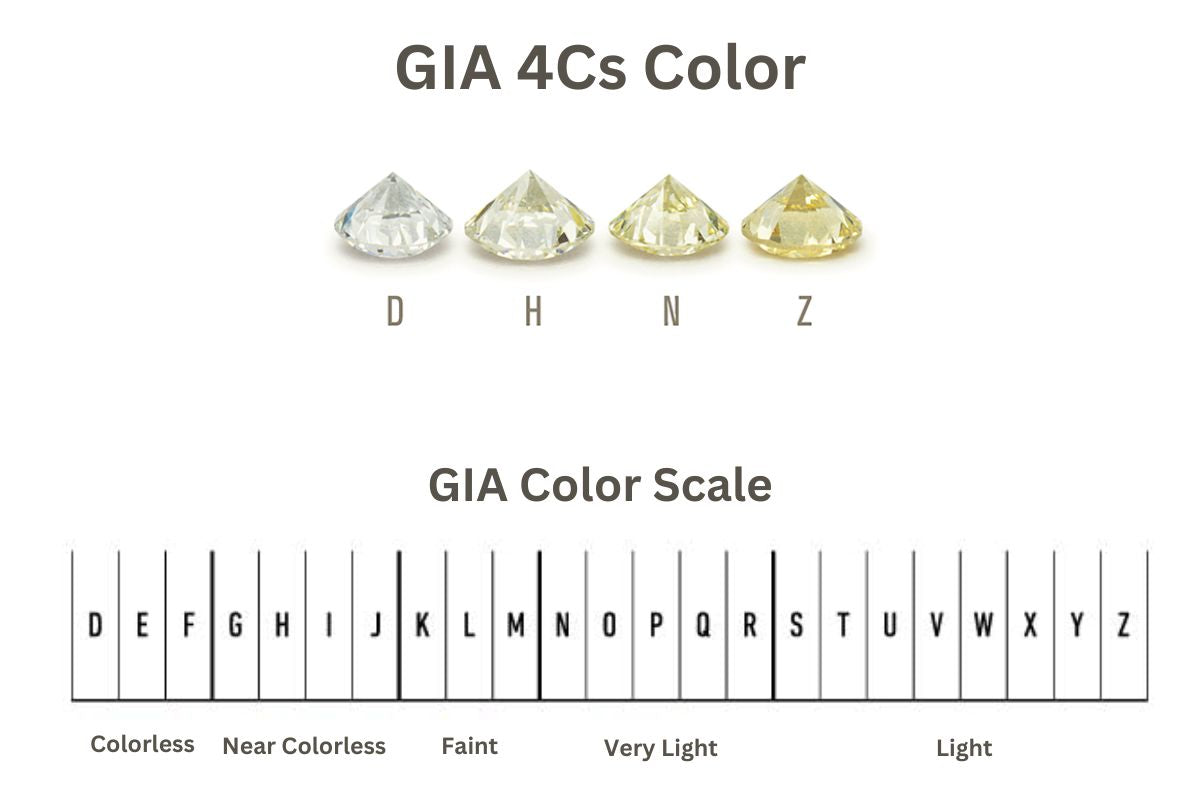
In assessing the quality and grading of marquise cut diamonds, I consider several crucial aspects such as shape, color, clarity, and cut parameters. These factors are all instrumental in determining the overall appeal and value of the diamond.
Evaluating Diamond Shape
Within the overall diamond shape, I specifically examine the marquise shape for its unique qualities.
A marquise shaped diamond should display a symmetrical football-like appearance with pointed ends.
The ideal length-to-width ratio for marquise diamonds tends to range around 2.00, but this preference may vary slightly based on aesthetic desires.
Symmetry is paramount; any deviation can significantly affect the diamond's balance and brilliance.
Diamond Color and Clarity
When I look at diamond color and clarity, my emphasis is on how these elements influence the diamond's appearance.
GIA's color grading scale ranges from D (colorless) to Z (light color). For marquise cut diamonds, staying within the range of D to H often ensures a white appearance.
Clarity grades assess the absence of inclusions and blemishes.
I look for grades ranging from Flawless (FL), Internally Flawless (IF), Very Very Slightly Included (VVS1 and VVS2), Very Slightly Included (VS1 and VS2), to Slightly Included (SI1 and SI2).
Marquise cuts may show color and inclusions more easily than other shapes, so selecting higher grades can be beneficial.
Cut Parameters and Symmetry
The cut of a marquise diamond is a complex interplay of proportions, facet angles, and polish that dictates its sparkle and fire.
I carefully review the diamond's cut parameters to ensure they fall within ideal or excellent ranges according to GIA or AGS certification.
This includes checking the diamond's polish and symmetry ratings, which should ideally be very good or excellent.
Diamonds with fair or poor symmetry may result in a loss of overall sparkle and may not reflect light as effectively.
Choosing the Right Setting
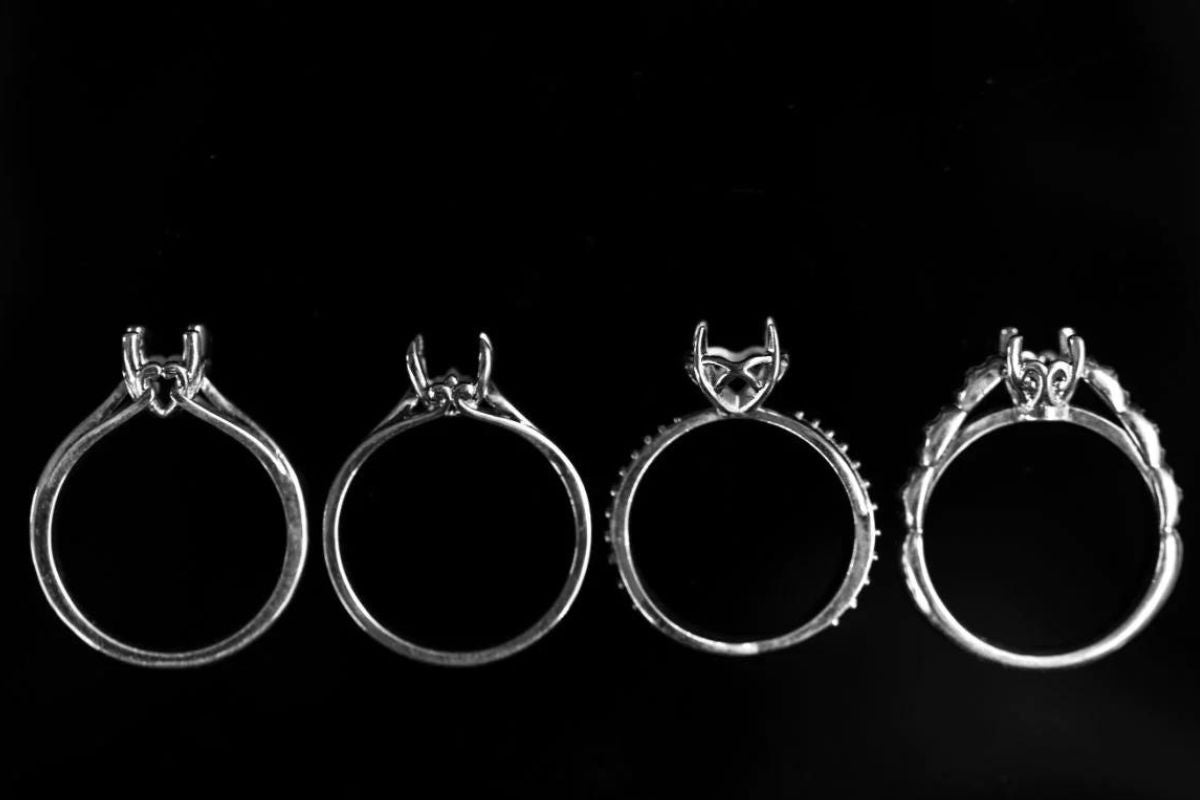
When selecting a setting for a marquise diamond, I consider both aesthetics and protection. The right setting enhances the diamond’s appearance and ensures its durability.
Best Settings for Marquise Diamonds
- Popularity: High, due to its timeless elegance.
- Structure: Features a single diamond as the focal point.
- Metal: Often paired with yellow gold for a classic look.
- Characteristics: Encircles the marquise diamond with smaller diamonds.
- Benefits: Amplifies the diamond's size and brilliance.
- Definition: Small diamonds line the band, accentuating the center stone.
- Visual Appeal: Offers additional sparkle to the engagement ring.
Protection and Prongs
Prong Tips:
- Number: Typically, six prongs are recommended for marquise diamonds.
- Purpose: Prongs secure the stone and protect the pointed ends.
V-Prongs:
- Specific Use: Cover the diamond's tips to prevent chipping.
- Advantage: Tailored to protect the vulnerable areas of a marquise cut.
French Tips:
- Explanation: A variation of the prong that covers the tips with less metal.
- Reason: Offers protection while allowing more diamond visibility.
I make sure the prongs are set properly. Then, I check for symmetry. This is essential in the marquise cut to maintain both the visual appeal and integrity of the diamond.
Sizing and Appearance on the Finger
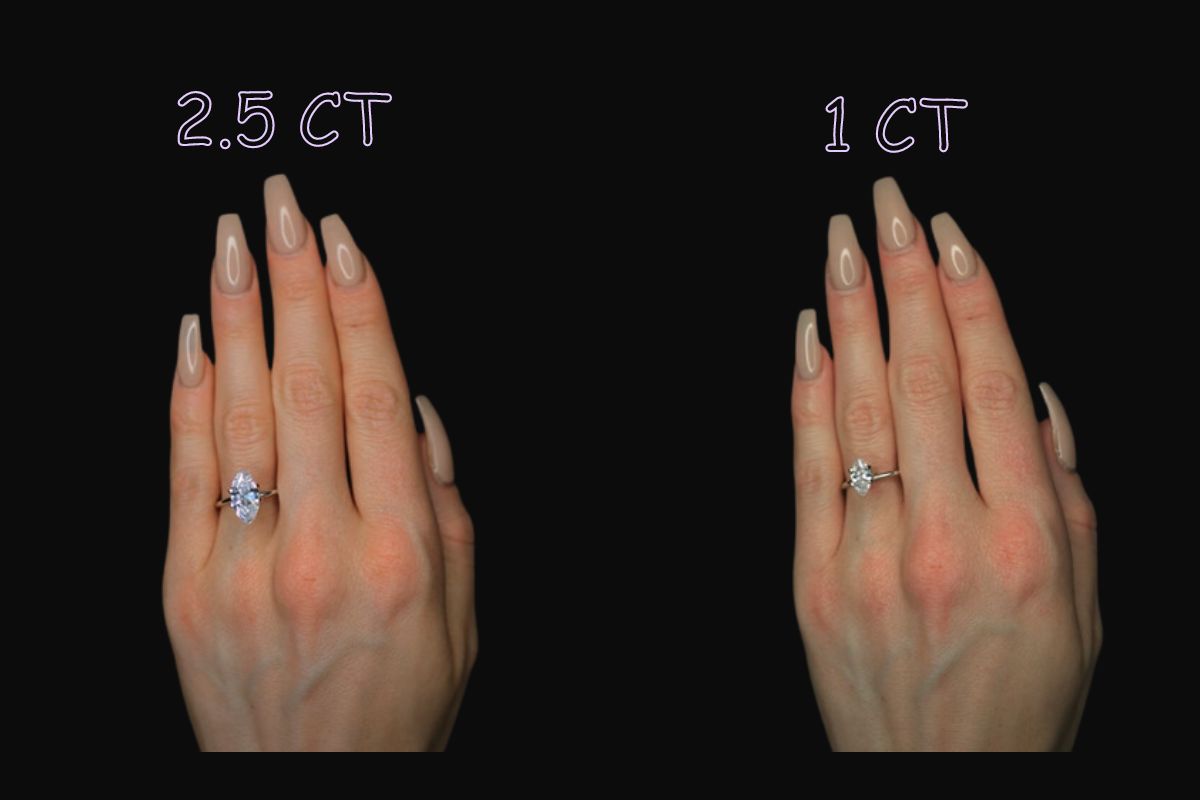
Choosing the right size for a Marquise cut diamond is essential for ensuring that the engagement ring looks elegant and proportionate on the finger. My aim is to help you understand how different carat sizes can affect the ring's presence. I also want to provide tips for selecting the most flattering option.
Optimal Carat Sizes
In my experience, Marquise cut diamonds tend to appear larger than other shapes of the same carat weight because of their elongated shape. Here are typical size-to-weight conversions you might consider:
- 6x3 mm: Generally equates to 0.25 carat
- 8x4 mm: Usually around 0.50 carat
- 9x4.5 mm: Often corresponds to a weight just under 0.75 carat
Keep in mind that these measurements are averages and can vary based on the specific proportions of the diamond.
Visual Impact on the Hand
A Marquise cut engagement ring can have a remarkable impact on the appearance of the wearer's hand. It makes fingers appear longer and slimmer. The unique shape and the placement of the diamond along the finger play a crucial role in its visual appeal. For example, a 1-carat Marquise diamond will cover more of the finger's width than a round cut of the same weight. This delivers a striking sparkle and an impression of greater size.
Selection Tips for Maximum Elegance
When I advise on selecting a Marquise diamond for an engagement ring, I stress the importance of proportion and balance. If your aim is to make the finger look slimmer, a narrower Marquise diamond is preferable. It's also vital to consider the ring setting. A setting that exposes more of the diamond can enhance its elegance and accentuate its length. For engagement rings or recently purchased rings, it's wise to try different carat sizes on the hand. This way, you can see which looks the most harmonious and reflects your personal style.
Purchasing and Certifications

When I purchase a diamond, I focus on certification and reputable sourcing to ensure both quality and value. A certification from recognized institutions like GIA or AGS is crucial, as it guarantees the diamond's authenticity and quality.
Choosing Certified Diamonds
I always recommend selecting diamonds that are certified by established gemological institutes. Certified diamonds have been thoroughly assessed by diamond experts. They provide a detailed report on their characteristics and quality.
For marquise cut diamonds, certifications from the Gemological Institute of America (GIA) or the American Gem Society (AGS) are particularly important. They set industry standards for diamond grading.
- GIA Certification: Assures the diamond's cut, color, clarity, and carat weight are evaluated based on stringent criteria.
- AGS Certification: Known for its comprehensive cut grading system. This is especially beneficial for fancy shaped diamonds like the marquise cut.
When it comes to long-term satisfaction, I also look for a vendor that offers a lifetime warranty. This provides added assurance on my investment.
Shopping Tips
My approach to buying a diamond involves a mixture of strategic search and expert consultation. Here are some specific tips:
- Budget: Determine my budget before starting my search. This allows me to narrow down options efficiently.
- James Allen: I often explore online retailers like James Allen for a seamless purchase experience. They offer high-definition images of certified diamonds within my price range.
- Expert Advice: Consulting with diamond experts can provide insight into the nuances of the marquise cut. They can also help me find the best diamond for an engagement ring or other jewelry piece.
Creating a checklist of these priorities ensures I make informed decisions. It helps me find the right certified diamond that meets my expectations and budget.
Advanced Considerations

In this section, I'll explore the intricacies of Marquise cut diamonds. I'll focus on prevalent issues and ways to avert them. I'll also talk about the nuances of selecting melee diamonds that complement the primary stone.
Common Flaws and How to Avoid Them
- Shape and Proportions: When examining Marquise cut diamonds, the shape is critical. An ideal length-to-width ratio falls between 1.85 and 2.10, ensuring an appealing balance. A deviation from this range can create an awkward appearance. Mind the depth percentage, too. Too deep a cut hides weight below the girdle, whereas too shallow a stone refracts less light.
- Bow-tie Effect: Beware of the bow-tie — a dark shadow resembling a men's bow-tie which can be seen in poorly cut Marquise diamonds due to improper reflection of light. To avoid this, I examine the diamond under various lighting conditions. I ensure that no prominent bow-tie is present. Viewing the diamond in motion helps as well, as bow-tie visibility can change with perspective.
- Flaws (Inclusions and Blemishes): A diamond's table, the large facet on top, should be clean and without obvious inclusions, which can impact brilliance. Insisting on high clarity grades, typically VS2 or better, minimizes the risk of noticeable flaws.
Accompanying Melee Diamonds
When complementing a Marquise cut with melee diamonds, consistency in cut quality is paramount.
These small companions should match in color and clarity to avoid drawing attention away from the Marquise's vintage allure.
Strong colored melees may clash, while those with lower clarity might lack the necessary sparkle.
Table Guidelines for Melee Diamonds:
- Melee Color: Match within one grade of the Marquise.
- Melee Clarity: Equal to or one grade below the Marquise.
- Melee Cut: Excellent to maximize reflected light synergy.
Marquise Diamond Care and Maintenance
Caring for my marquise diamond is crucial to maintaining its brilliance and ensuring its longevity. Marquise diamonds, with their elongated shape and pointed ends, are more prone to chipping if not handled with care.
Here’s how I keep mine in top condition:
- Routine Cleaning: I clean my marquise diamond regularly to keep it sparkling. A simple mixture of warm water with mild dish soap and a soft toothbrush help remove any buildup. I always ensure to rinse my diamond thoroughly and dry it with a lint-free cloth.
- Professional Check-ups: I schedule professional cleanings and inspections at least twice a year. This not only keeps my diamond dazzling but also allows for the checking of the settings and polish/symmetry maintenance.
- Storage: When I'm not wearing my marquise diamond, I keep it stored separately from other jewelry to prevent scratches. A fabric-lined jewelry box with dividers is ideal to protect its unique shape.
- Avoiding Harsh Chemicals: I make sure to remove my marquise diamond ring before using harsh chemicals or engaging in strenuous activities. Exposure to such environments can damage the polish and erode the metal over time.
Also Read
Frequently Asked Questions
In this section, I'll go over some common inquiries regarding marquise cut diamonds, focusing on size measurements, calculation methods, and factors affecting their appeal and value.
What is the typical millimeter size range for marquise diamonds?
Marquise diamonds are available in a variety of sizes.
On average, a marquise diamond can range from 6x3mm for smaller stones around 0.25 carat to larger dimensions for heavier carats. It's common to see these diamonds increase in length and width proportionally with their carat weight.
How can one calculate the carat weight of a marquise diamond based on its millimeter dimensions?
The carat weight of a marquise diamond can be roughly estimated from its millimeter dimensions.
Each diamond cut has its own conversion formula; however, a precise calculation must consider the diamond's depth and specific proportions, which can vary. Professionals use standardized charts or digital tools for accurate conversions.
What proportions are considered ideal for a marquise cut diamond?
Ideal proportions of a marquise diamond usually have a length to width ratio (L/W ratio) between 1.85 to 2.00.
This range typically yields an elegant shape that is neither too narrow nor too wide, enhancing the diamond's overall appearance and brilliance.
How do marquise diamond sizes compare on the hand?
Marquise diamonds tend to appear larger on the hand compared to other diamond shapes of the same carat weight due to their elongated form and larger surface area.
Their unique shape can also make the wearer's fingers appear longer and more slender.
What factors influence the price of a marquise cut diamond?
The price of a marquise cut diamond is influenced by several factors, including the Four Cs: carat weight, cut quality, color, and clarity.
Additionally, the diamond's length-to-width ratio and the presence of any bow-tie effect (a dark area in the center resembling a bow tie) can impact its value.
How does the size of a marquise diamond affect its perceived beauty and quality?
The size of a marquise diamond can influence its perceived beauty. Larger diamonds typically display more pronounced sparkle and brilliance.
However, a well-cut marquise diamond can exhibit a high-quality appearance if it has good symmetry, polish, and optimal proportions. This is true regardless of its size.
Checkout some of our top collections:

